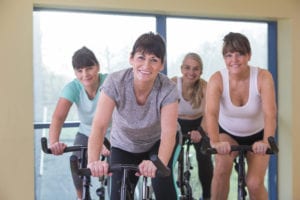Written by Angeline A. De Leon, Staff Writer. Participating women (aged 63-69) demonstrated a strong inverse association between daily physical activity and the risk of mortality.
 The aging of the baby-boomer generation has precipitated a health care crisis calling for a strategic support system to accommodate an aging society. Other than diet and stress management, one of the most impactful lifestyle changes that can be made to promote health even in advanced stages of life is physical activity (PA). In fact, moderate-to vigorous-intensity physical activity (MVPA) is strongly related to significantly lower overall mortality rates 1, although it is unknown whether this trend is also applicable to the older adult population. While U.S. public health guidelines recommend for older adults to complete at least 2.5. hours of moderate-intensity or 1.25 hours of vigorous-intensity exercise weekly 2, very few older individuals are capable of such activity. In clinical studies examining PA in older adults, the majority have focused on light-intensity physical exercise, which seniors are more apt to engage in, however, without accelerometer-based measures of physical activity to validate the energy costs of PA for older adults (in comparison to younger adults for whom the use of accelerometers is standard in exercise studies), the association between PA and health outcomes remains poorly understood in older individuals 3,4. In order to confirm whether the link between PA and mortality is similar for both younger and older adults, LaMonte and colleagues at the University at Buffalo in New York examined the relationship between mortality and accelerometer-measured PA in a group of older adult women.
The aging of the baby-boomer generation has precipitated a health care crisis calling for a strategic support system to accommodate an aging society. Other than diet and stress management, one of the most impactful lifestyle changes that can be made to promote health even in advanced stages of life is physical activity (PA). In fact, moderate-to vigorous-intensity physical activity (MVPA) is strongly related to significantly lower overall mortality rates 1, although it is unknown whether this trend is also applicable to the older adult population. While U.S. public health guidelines recommend for older adults to complete at least 2.5. hours of moderate-intensity or 1.25 hours of vigorous-intensity exercise weekly 2, very few older individuals are capable of such activity. In clinical studies examining PA in older adults, the majority have focused on light-intensity physical exercise, which seniors are more apt to engage in, however, without accelerometer-based measures of physical activity to validate the energy costs of PA for older adults (in comparison to younger adults for whom the use of accelerometers is standard in exercise studies), the association between PA and health outcomes remains poorly understood in older individuals 3,4. In order to confirm whether the link between PA and mortality is similar for both younger and older adults, LaMonte and colleagues at the University at Buffalo in New York examined the relationship between mortality and accelerometer-measured PA in a group of older adult women.
A total of 6,382 community dwelling women (aged 63-99 years) participated in a prospective cohort study. Participants were instructed to wear a triaxial accelerometer on the hip for seven consecutive days during waking and sleep hours (acceleration data from all three planes were averaged and reported as mean total PA). Duration of PA was monitored daily and physical functioning was evaluated using the Short Physical Performance Battery (SPPB). All-cause mortality was monitored with an average follow-up period of 3.1 years.
Total PA was divided incrementally according to intensity: low light-intensity, high light-intensity, and MVPA. After controlling for confounding variables and adjusting for physical function, strong inverse associations with all-cause mortality were detected for total PA (Relative Risk = 1.00; 95% Confidence Interval: 0.68-0.49, p < 0.001), high light-intensity (RR = 1.00; 95% CI: 0.57-0.47, p < 0.001), and MVPA (RR = 1.00; 95% CI: 0.63-0.42, p < 0.001). Each 30-minute/day increment was associated with a 12% lower average mortality risk for both total PA and light-intensity (both low- and high-intensity) PA and a 39% lower average mortality risk for MVPA (p < 0.01 for all). The relationship between MVPA and mortality was also stronger in women with lower physical function based on the SPPB (RR = 0.56) vs. higher physical function (RR = 0.77; interaction P = 0.009).
Results of the study support the suggestion that physical activity, as measured based on accelerometer data, is linked to lower all-cause mortality in older adults, even when exercise is below the recommended moderate-intensity threshold. Engagement in consistent light-intensity activity may represent a more practical approach to combatting the detrimental effects of age-related sedentariness, and therefore, warrants greater emphasis in the older adult population. Mixed gender confirmatory studies are warranted to validate current findings.
Source: LaMonte MJ, Buchner DM, Rillamas-Sun E, et al. Accelerometer-measured physical activity and mortality in women aged 63 to 99. Journal of the American Geriatrics Society. 2017; DOI: 10.1111/jgs.15201.
© 2017 Copyright the Authors
Posted February 6, 2018.
References:
- Arem H, Moore SC, Patel A, et al. Leisure time physical activity and mortality: a detailed pooled analysis of the dose-response relationship. JAMA internal medicine. 2015;175(6):959-967.
- Barnes PM, Schoenborn CA. Physical activity among adults, United States, 2000. US Department of Health and Human Services, Centers for Disease Control and Prevention, National Center for Health Statistics; 2003.
- Pettee KG, Mcclain JJ, Lee CD, et al. Evaluation of physical activity measures used in middle-aged women. Medicine and science in sports and exercise. 2009;41(7):1403-1412.
- Troiano RP, Berrigan D, Dodd KW, Masse LC, Tilert T, McDowell M. Physical activity in the United States measured by accelerometer. Medicine and science in sports and exercise. 2008;40(1):181.

